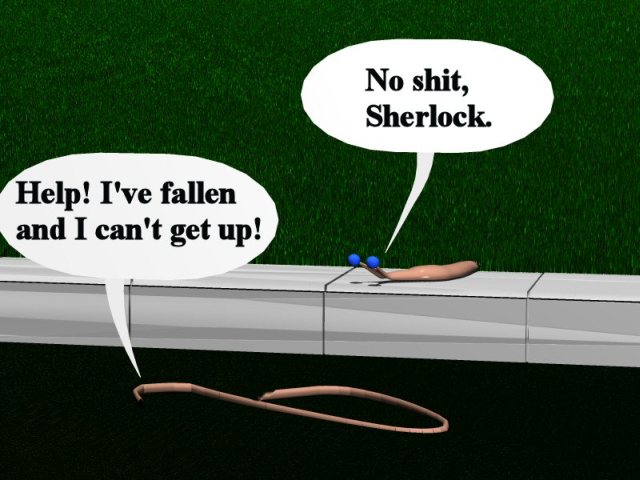Saturday, March 29, 2014
Worm puzzle
We had a slow steady rain last night. About 1/4 inch, which is nothing special for Spokane. When we get any rain at all, it tends to hit 1/4 inch. A half inch is special, 3/4 is once per season.
Despite the nothingspecialness, the streets are absolutely covered with earthworms this morning. The quantity is enough to verify a question I've been wondering about.
I watched carefully during my morning walk. The worm density in the street varied from about 5 w/sqft near the center of the street to 1 w/sqft near the curb. On top of the curb, exactly 0 w/sqft.
Puzzle: Why don't they stay on the curb?
If they were simply responding to a basic tropism ... as in "Fuck! I can't breathe in here! I need some damn AIR!" ... they would reach the curb and stay there. The curb is actually less damp than the street, but the curb-seeking worm wouldn't need to make the comparison. It would reach the nice dry surface and bask.
But that's not what they do. They cross the curb and proceed as far as possible from the soil.
One possibility: The curb-staying worms had returned to the soil before my walk, and the street-seeking worms got hit by cars. Might be part of the answer, but traffic is sparse this morning and only about 5% of the street worms look squashed. Most appear fully 3-dimensional and fully dead.
Later: Maybe it's just a matter of gravity and dimensions. Getting onto the curb from the soil is easy because the soil is typically even with the curb or above the curb. A typical worm is longer than the width of a curb. By the time the rear end is on the curb, the front end has dropped toward the street, and it's too late to pull back. After the worm has fallen onto the street surface, the vertical curb is too high to climb. However: This wouldn't explain why slugs also end up in the same distribution pattern. Slugs are sticky and have better senses and better control. A slug would be able to stay on a curb if it wanted to, and a slug can easily climb a vertical curb.
 Sidenote for SI fanatics: 5 worms per square foot would be 53.82 worms per square meter, or 53.82 wm-2. Obviously more exact and convenient than the old-fashioned primitive neanderthal English form.
= = = = =
Update 9/24/16: Saw it happen! Not on a curb but on a retaining-wall. Even better, Googlestreet has a nice view of the place, sparing me the trouble of 'drawing' the situation. The worm was trying to escape from the saturated soil behind the fence. (Sprinkler had just turned off.) It managed to pull up onto the paver, then wriggled across the paver to get more distance from the water. Fell off the edge. Fortunately there's enough soil between the pavers and the solid wall that the worm could burrow down into the soil. Happy ending.
Sidenote for SI fanatics: 5 worms per square foot would be 53.82 worms per square meter, or 53.82 wm-2. Obviously more exact and convenient than the old-fashioned primitive neanderthal English form.
= = = = =
Update 9/24/16: Saw it happen! Not on a curb but on a retaining-wall. Even better, Googlestreet has a nice view of the place, sparing me the trouble of 'drawing' the situation. The worm was trying to escape from the saturated soil behind the fence. (Sprinkler had just turned off.) It managed to pull up onto the paver, then wriggled across the paver to get more distance from the water. Fell off the edge. Fortunately there's enough soil between the pavers and the solid wall that the worm could burrow down into the soil. Happy ending.

 Sidenote for SI fanatics: 5 worms per square foot would be 53.82 worms per square meter, or 53.82 wm-2. Obviously more exact and convenient than the old-fashioned primitive neanderthal English form.
= = = = =
Update 9/24/16: Saw it happen! Not on a curb but on a retaining-wall. Even better, Googlestreet has a nice view of the place, sparing me the trouble of 'drawing' the situation. The worm was trying to escape from the saturated soil behind the fence. (Sprinkler had just turned off.) It managed to pull up onto the paver, then wriggled across the paver to get more distance from the water. Fell off the edge. Fortunately there's enough soil between the pavers and the solid wall that the worm could burrow down into the soil. Happy ending.
Sidenote for SI fanatics: 5 worms per square foot would be 53.82 worms per square meter, or 53.82 wm-2. Obviously more exact and convenient than the old-fashioned primitive neanderthal English form.
= = = = =
Update 9/24/16: Saw it happen! Not on a curb but on a retaining-wall. Even better, Googlestreet has a nice view of the place, sparing me the trouble of 'drawing' the situation. The worm was trying to escape from the saturated soil behind the fence. (Sprinkler had just turned off.) It managed to pull up onto the paver, then wriggled across the paver to get more distance from the water. Fell off the edge. Fortunately there's enough soil between the pavers and the solid wall that the worm could burrow down into the soil. Happy ending.

Labels: Heimatkunde
